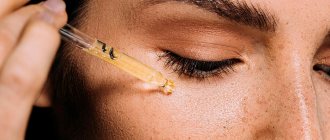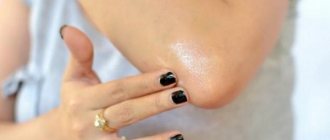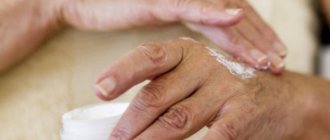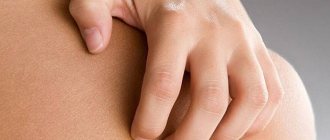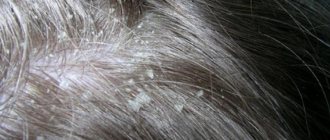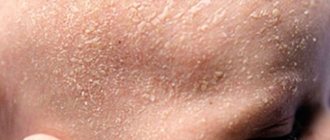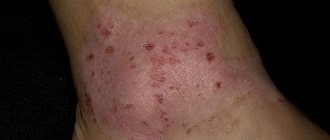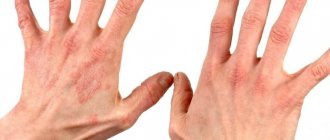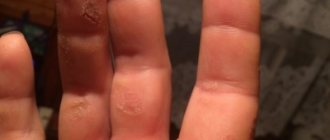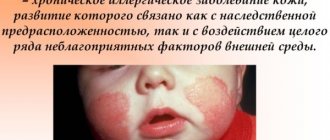It is impossible not to notice an inflammatory disease of the skin in the groin area. The skin turns red, itches, becomes covered in a rash, and an unpleasant odor appears. Dermatitis in the groin can develop in men and women for various reasons. The disease can be infectious, caused by intolerance to certain substances or autoimmune factors. Therefore, only a doctor after an examination can answer the question of how to treat dermatitis.
The skin disease can affect any part of the body, including the groin area. Many patients, feeling discomfort, are embarrassed to see a doctor, trying to cope with the disease on their own. But this will not be easy to do, since before treating dermatitis, you need to find out the reasons for its occurrence. Only in this case is it possible to prescribe adequate treatment.
Clinical picture
Manifestations of inguinal dermatitis depend on the stage of development of the disease:
- At the initial stage, dermatitis in the groin in women or men is manifested by the appearance of red spots, but the skin remains intact. Patients feel severe itching;
- If left untreated, the disease enters the middle stage and rashes appear on the skin. They can be in the form of vesicles or papules;
- with severe damage, the appearance of extensive weeping surfaces covered with crusts is noted. At this stage, secondary infection is often observed, the symptoms of which are the formation of abscesses.
Damage area
With inguinal dermatitis, the following areas are affected:
- inner thigh;
- inguinal and gluteal folds;
- pubis;
- In a man, the skin of the scrotum may be damaged.
If the disease occurs in a chronic form, the following symptoms are noted:
- changes in the color of the skin in places where inflammation develops, it becomes cyanotic;
- the epidermis becomes dry, keratinized;
- Painful cracks form on damaged surfaces.
Prevention of dermatitis in the intimate area
Preventive measures are aimed at prolonging the period of remission and reducing the risk of recurrent infection in the groin area.
Personal hygiene plays an important role not only in the process of treatment and getting rid of the disease, but also in its prevention.
It is very important to maintain hygiene and reduce exposure to factors that provoke the disease. To prevent genital dermatitis, you must:
- wear underwear only made from natural fabrics;
- immediately treat injuries on the body with antiseptics;
- use hypoallergenic hygiene products;
- include foods with vitamins E, C and B in your diet;
- promptly treat skin pathologies;
- treat the skin in the intimate area with special creams;
- for excessive sweating, use antifungal powders or talc;
- refuse to use other people's hygiene products.
Wearing clean and dry clothes made from natural materials prevents excessive sweating and the proliferation of opportunistic microorganisms in the groin area. To prevent the re-development of dermatitis, it is advisable to use multivitamin complexes in the autumn-spring period, as well as promptly treat ENT infections and exacerbations of chronic diseases.
Infection
The infectious version of inguinal dermatitis can be caused by various pathogens.
Viral
Dermatitis is caused by the genital herpes virus. Infection occurs through sexual contact. Main symptoms:
- the appearance of red spots;
- the formation of blisters filled with serous fluid;
- pain and itching in the affected area;
- after the bubbles open, weeping erosions form.
Advice! Rashes with genital herpes can be located not only on the genitals, but also on the skin of the thighs, pubis or buttocks. Therefore, the disease is classified as inguinal dermatitis.
Bacterial
Various bacteria are the primary source of dermatitis, but often a bacterial infection is a complication of dermatitis of another nature. With this type of disease, in addition to the main symptoms, the formation of purulent crusts is noted.
Advice! A bacterial infection often occurs when the patient scratches the skin. With dermatitis of any nature, one of the main symptoms is itching. Scratching damages the skin. And scratches and abrasions are entry points for infection.
Bacterial dermatitis in the groin area in a child often develops due to intestinal dysbiosis. With this disease, frequent loose stools occur, which irritate the skin, and then a bacterial infection occurs.
In adult patients, inguinal erythrasma may cause skin irritation. This disease is caused by a specific bacterium; infection occurs through close contact, most often through sexual intercourse.
Advice! The cause of the development of inflammatory skin disease in the groin area can be STDs caused by chlamydia, mycoplasma, and ureaplasma. A sick person's immunity decreases, and discharge from the genitals irritates the skin, which causes inflammation.
Fungal
The groin area is one of the most favorable places for the development of fungal infections. The development of dermatitis of a fungal nature can develop in a person of any age. The most common variant is candidal dermatitis, caused by fungi of the genus Candida.
In addition, dermatitis in the groin area can be caused by demortophytic fungi. A fairly common disease is athlete's foot. With this disease, red spots in the shape of rings form on the skin. They are usually located in the area of natural folds. Then a rash appears in the form of small blisters.
Seborrheic dermatitis also belongs to the group of fungal diseases; its development is caused by the Malassezia fungus, which feeds on the secretions of the sebaceous glands. This disease can develop at any age, but if in adult patients it is difficult and long to treat, then with seborrheic dermatitis in the groin of a child, long-term treatment is not required. The disease often goes away on its own.
Parasitic
Parasites can cause the development of an inflammatory reaction of the skin, these are:
- worms;
- pubic lice;
- scabies mite.
You can become infected with parasites through close contact with a sick person; helminthic infections are often associated with poor hygiene. With parasitic infections, the skin is very itchy, and the scratching often gets a bacterial infection, so dermatitis in this case has a dual nature.
Symptoms and methods of treatment of exudative psoriasis
Dear friends, hello. Today you will learn everything about exudative psoriasis: symptoms, treatment and prevention rules. I will say right away that this is a severe degree of the disease, so read the article carefully in order to recognize it in time and begin timely therapy.
What it is?
Exudation is a pronounced inflammatory process. This is where the name came from. This type of widespread psoriasis is characterized by:
- Multiple dense papules that rise above the skin;
- The inflamed areas have irregular outlines;
- The formations are covered with a gray or yellow purulent crust;
- If you scrape off a papule, you will find wet or bleeding skin underneath;
- If you do not start treating the disease in time, the crusts of the papules will merge into one large area;
- All formations are very itchy;
- The main lesions are located in non-standard places for psoriasis: on the knees, elbows, armpits, near/under the mammary glands, on the genitals; rarely - on the scalp (seborrheic psoriasis);
- In case of mechanical impact, formations can be injured, as a result of which there is a risk of infection entering the body;
- Often the disease is accompanied by nervous exhaustion and constant insomnia;
- If the disease affects the lower limbs, there is a risk of varicose veins.
I note that this form of psoriasis is active throughout the patient’s life. Its course is accompanied by exacerbations, relapses and periods of remission.
If treated correctly, the disease can be maintained in remission for a long time. But during exacerbation, concomitant somatic diseases may appear.
Look at a photo of the disease to know exactly what it looks like.
Have you been trying to get rid of PSORIASIS for many years?
Head of the Institute: “You will be amazed at how easy it is to get rid of psoriasis by taking it every day...
Read more "
Causes of the disease
Until now, the true causes of the disease are not known. Dermatologists believe that this form is a consequence of autoimmune disorders, as well as genetic predisposition.
Provoking factors are:
- Persistent infections;
- Stressful conditions;
- Problems with the endocrine system (diabetes mellitus, underactive thyroid gland, obesity);
- Frequent hypothermia;
- Having bad habits;
- High blood pressure;
- Elderly age.
Exudative psoriasis: forms and stages
There is a classification of the disease according to the type of primary elements. This is what all dermatologists adhere to to prescribe the correct treatment. After all, if the wrong diagnosis is made, then a secondary type of inflammation may occur based on an already existing inflammatory reaction. Forms of exudative psoriasis:
- Pillar plaque, which is associated with obesity. The majority of the disease affects males. The prognosis for the disease is unfavorable. The disease affects the nails, and psoriatic polyarthritis develops. In addition to general treatment, it is necessary to prescribe medications that will correct fat metabolism, as well as anti-rheumatoid drugs;
- Thin plaque, diagnosed due to diabetes mellitus and other endocrine pathologies. It can also occur in children with the above problems.
How is the disease diagnosed?
Exudative psoriasis is diagnosed by a dermatologist in accordance with clinical manifestations and medical history. It is differential diagnosis that is important here.
It is necessary to determine the patient’s immune status in order to assess the severity of the disease, as well as prescribe adequate therapeutic measures. For this purpose, immunohistochemical studies are carried out: the level of immunoglobulins IgM, IgA, IgG, as well as the cytokine profile are determined.
It is also important to determine the involvement of joints in the inflammatory process. For this purpose, an immunological examination, biochemistry, and x-ray are prescribed. The patient may be referred for arthroscopy, ultrasound, or densinometry (measurement of bone tissue).
It is important to consult an endocrinologist, surgeon, or rheumatologist.
(adsbygoogle = window.adsbygoogle || []).push({});
Treatment of the disease
Specialists can relieve the patient from signs of the disease, as well as maintain the remission stage for as long as possible. A set of measures is important that can reduce inflammation and also suppress the process of secretion of inflammatory fluid.
Physiotherapeutic methods
These are paraffin therapy, ultraviolet irradiation, hemosorption, plasmapheresis. Modern medicine also offers laser treatment. The most effective is the combination of the photothermal, photochemical, photomechanical effect of the excimer laser system.
After the inflammatory process has passed, the patient sees stable improvements, it is recommended to undergo a course of sanatorium treatment.
Non-infectious nature
You can get dermatitis not only in case of infection. This disease can be triggered by systemic diseases that occur in the body.
Allergic
Allergic inguinal dermatitis is the most common non-infectious form. The disease can be caused by direct contact with an allergen (for example, when wearing synthetic underwear) or by eating certain foods, interacting with chemicals, pollen, etc.
Allergic dermatitis develops due to an inadequate response of the immune system to certain irritants. The body produces histamine, a substance that helps destroy foreign bodies that enter the body. The main functions of histamine:
- slows down blood circulation at the site of invasion of foreign agents, which is necessary to prevent its spread throughout the body;
- increases the permeability of small vessels so that cells “attacking” foreign bodies can move freely.
Thus, the skin at the site of the lesion swells and turns red. A similar reaction occurs when the immune system mistakes ordinary substances for “strangers.” If the inflammatory reaction continues for a long time, then the allergy becomes chronic, it turns into atopic dermatitis.
Advice! The difference between allergenic and atopic dermatitis is not clear to many, since both diseases have a similar development pattern. However, the allergic variety passes quickly after contact with the irritant is eliminated. Atopic dermatitis is a chronic disease that is often inherited.
Eczema
It is also a type of dermatitis that can affect the skin in the groin area. This disease manifests itself for the following reasons:
- in case of metabolic disorders;
- under severe stress, prolonged nervous tension;
- in case of malfunction of the endocrine system;
- with decreased immunity.
Eczema most often affects women, but men can also develop this disease.
Psoriasis
This disease often affects the groin area. The skin in the affected areas becomes bright pink, it peels or becomes wet. It is of an autoimmune nature, and the tendency to develop psoriasis is inherited.
How to treat?
To treat inguinal dermatitis, you do not need to use special medical equipment. This procedure is very simple, but this does not mean that you can do the treatment yourself, without the help of a qualified specialist. Before using any medication, you must consult a dermatologist. As a rule, doctors prescribe external medications, but sometimes various folk remedies can be used as a supplement.
Medicines
Before prescribing treatment for dermatitis on the labia, penis or other intimate places, the doctor must determine the cause of the symptoms. Only after the cause of the disease has been established can treatment be started.
Most often, doctors prescribe:
- therapy of external medications (creams, ointments, gels);
- periodic use of botulinum toxin. About twice a year. This drug is administered by injection.
If traditional medications do not help get rid of dermatitis, then doctors prescribe surgery. The most common method is to cauterize the sympathetic nerve using an electrical current. This allows you to get rid of unpleasant symptoms for several years. As an adverse reaction, sweating may occur in other parts of the patient's body. But this is rather a rarity than the norm.
Folk remedies
Some people simply do not trust modern medicine, preferring traditional methods of treating inguinal dermatitis. There are a large number of recipes for this that contain natural ingredients. Dermatologists often prescribe treatment with proven folk remedies as a complement to traditional methods.
Such means include:
- prepare a tincture of oak bark . To do this, you need to add 100-150 grams of bark to one liter of clean water. All this needs to be boiled for 15-20 minutes, after which place the vessel with the liquid in a dark place to infuse. After 3 hours, the decoction is ready for use. Apply the product to damaged areas of the skin using a medical swab or gauze. This needs to be done several times a day. Alternatively, you can use the prepared broth as a lotion;
- tincture of chamomile . To prepare, you need to add 20 grams of chamomile to 500 grams of boiling water. Let the broth brew for 4-5 hours. After this, you need to strain the liquid through several layers of gauze. This product should be used when performing hygiene procedures. Number of procedures per day – 2-3;
- Another recipe that includes vegetable oil. Boil 200 grams of vegetable oil in a water bath. Then, when the product has cooled to room temperature, apply it to the affected areas of the body. It is advisable to repeat this procedure 2 times a day. Continue until the symptoms of inguinal dermatitis completely disappear.
Features of treatment during pregnancy
During pregnancy, self-medication is strictly prohibited. Only with the help of a qualified specialist can you get rid of the disease without harm to the body of the mother and her baby. Very rarely, doctors prescribe drugs for internal use. These are sedatives and antihistamines.
Ointments are usually used to treat inguinal dermatitis:
- Salicylic;
- Corticosteroid;
- Sea buckthorn;
- Eucalyptus and so on.
Don't forget about your diet either. During pregnancy, you need to give up alcohol, fried and salty foods, as well as coffee.
What medicinal and folk remedies can be used to cure dermatitis on the face?
Read about the possible causes and treatment of solar dermatitis in this article.
Therapeutic measures
Once the cause of the inflammation is determined, a treatment regimen will be prescribed. Depending on the nature of the disease, treatment for inguinal dermatitis in men can be prescribed not only by a dermatologist, but also by a urologist or andrologist. Women may require consultation and treatment with a gynecologist.
In case of a disease of an infectious nature, it is treated with specific drugs depending on the type of infection. Prescribed drugs:
- antiviral;
- antibiotics;
- antimycotic;
- antiparasitic agents.
In addition, the use of ointments that relieve inflammation and itching is prescribed. If the disease is caused by an allergy, then antihistamines are necessarily used in treatment. Hormonal ointments may be recommended to relieve severe inflammation.
They are used in short courses, since hormonal drugs, even when applied externally, can give negative side reactions. If the inflammation is minor, then the skin disease is treated with agents that promote faster cell regeneration. For example, D-Panthenol ointment may be prescribed.
Additional recommendations
For a faster recovery and to avoid relapses, it is recommended to adhere to the following rules:
- Strict adherence to doctor's recommendations. It is not recommended to self-medicate, as this often leads to dermatitis becoming chronic and it will be much more difficult to get rid of it.
- Hygiene. For any type of dermatitis, you must carefully follow the rules of intimate hygiene. For skin care, choose mild soaps. You must have your own towel. If the disease is infectious in nature, then most likely, simultaneous treatment of the sexual partner will be required.
- Diet. Following a diet is important not only for the allergic nature of the disease. So, with fungal dermatitis, you need to abstain from sweets.
So, inguinal dermatitis in women and men can be caused by various reasons. In this case, the symptoms will be similar, so it is impossible to make a diagnosis on your own. If redness and itching appear in the groin area, do not delay treatment. It is necessary to contact a specialist and undergo the course of therapy prescribed by him.
Interview with an expert
Obstetrician-gynecologist Sibileva Ekaterina Andreevna
Itching in the intimate area is one of the most common complaints of gynecologist patients. Quite often, girls come with this problem after their first intimacy, pregnant women and those who have already entered menopause.
What are the most common causes of itching in the intimate area in women?
Itching in the intimate area in women can be caused by various diseases. Most often the cause is an infectious process. The examination usually reveals thrush, bacterial vaginosis, and nonspecific flora. Less common are specific infections - gonorrhea, chlamydia.
The second common cause is an allergic reaction. More and more women are complaining of itching and burning of the skin after using low-quality intimate hygiene products. Other causes of itching - endocrine diseases, serious dermatological problems - are much less common.
What medications can safely relieve itching temporarily if visiting a doctor is impossible in the near future?
Without examination and examination, it is impossible to say whether a fungus or an allergy is the cause of the itching.
Before visiting a doctor, you can alleviate the condition with the help of special intimate hygiene products. They are over-the-counter, soap-free and maintain an intimate pH of 4-5. They relieve itching and burning well, but remember - this is a temporary measure. Such remedies do not cure, but only temporarily relieve symptoms.
What could be the consequences of ignoring the problem?
The infection will progress and move from the vagina to the uterus, appendages, bladder, and can lead to infertility. The allergy will spread to other areas of the body. Other serious diseases will also develop without treatment and lead to complications. Don't delay your visit to the doctor.
Causes
Dermatophytosis inguinalis can be transmitted from infected animals or people through contaminated soil. The disease spreads contagiously.
The reasons for the development of pathology may be:
- Synthetic underwear that restricts movement. Such material does not allow air to pass through; a humid environment is a favorable condition for the development of infection.
- Excess weight. People who are obese are most susceptible to dermatophytosis inguinalis and irritation in the perineum.
- Lack or insufficient hygiene of the intimate area.
- Reduced or weakened immunity. When the body's defenses are weakened, pathogenic microorganisms and viruses entering the body begin to multiply rapidly, which is the cause of the disease.
- Injuries to the upper layer of the epidermis. Dermatophytes enter the body through minor microcracks, cuts or wounds.
- High humidity .
- Using other people's hygiene products.
- Allergies food and various chemicals.
Inguinal athlete's foot can develop in people whose professional activities involve prolonged sitting.
Regular and prolonged horse riding and taking corticosteroid medications may also be reasons.
In order for the treatment of inguinal dermatophytosis to be effective, it is necessary to establish the cause of the disease.
What folk recipes will help with groin dermatitis
- For baths and rubdowns, you can brew one hundred grams of oak bark with a liter of water. Cook for twenty minutes, then cover and let sit for several hours. Use the decoction after it has been strained. You can simply wipe the sore spot with a decoction of oak bark, or you can add it to the bath.
- To wash the penis and other affected areas of the groin area, brew two tablespoons of dried chamomile flowers in 500 ml of boiling water. Let it brew and use several times a day.
- You can also boil sunflower oil in a water bath and lubricate the areas affected by dermatitis in the groin area and labia several times a day.
Treatment also includes avoiding spicy and salty foods because they increase sweating. In addition to proper nutrition, treatment consists of wearing clothes made from natural, undyed fabrics. You need to wash your face with soap twice a day, and during a woman’s menstrual period, the number of washes needs to be increased.
In most cases, treatment of dermatitis on the penis, lips and other areas of the groin area is successful. If you change your approach to nutrition and the rhythm of life, and listen to the doctor’s recommendations, then the disease can be cured.
The article is presented for informational purposes. Treatment should only be prescribed by a doctor!
Diagnostics
A preliminary diagnosis is established after an external examination of the patient. The doctor determines the extent, location and severity of the disease.
The main goal of diagnosis is to detect the type of pathogen. This is necessary to determine the course of treatment. For this purpose, material is collected for research.
It can be:
- Hair.
- Scrapings from the affected area of skin where peeling is noted.
- Part of a nail.
The diagnosis is confirmed in cases where chains of conidia or mycelium threads are observed in the material taken during the study.
In order to quickly determine the presence of a fungus that provoked the development of inguinal dermatophytosis, a Wood's fluorescent lamp is used.
Special light gives the fungal spores a light green tint, which makes it possible to determine the causes of the disease. If necessary, your doctor may order other tests.
Only after determining the type of infection are certain drugs prescribed that have a detrimental effect on the fungus.
